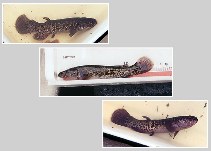| Family: |
Umbridae (Mudminnows) |
| Max. size: |
33 cm TL (male/unsexed); max.weight: 366.0 g; max. reported age: 8 years |
| Environment: |
demersal; freshwater |
| Distribution: |
North America: Alaska from Colville River delta south to central Alaska Peninsula near Chignik; upstream in Yukon-Tanana drainage to near Fairbanks. Also Bering Sea islands and northeastern Siberia, Russia. |
| Diagnosis: |
Dorsal spines (total): 0-0; Dorsal soft rays (total): 10-14; Anal spines: 0-0; Anal soft rays: 12-16; Vertebrae: 40-42. Identified by its short, flattened snout, the rearward location of the dorsal and anal fins, the presence of about 33 rays in the pectorals, and the presence of a pelvic fin that has only 3 rays (Ref. 27547). Gill rakers short; lateral line with minute pores: 76 to 100 scales in midlateral series (Ref. 27547). Dorsal located far back on body; anal more or less under dorsal; edge of pectorals rounded; pelvic fins very small and located just before anus; caudal broad and rounded (Ref. 27547). Dark green or brown above and on upper sides, pale below with dark speckles; four to six irregular dark bars or blotches on sides; fins have dark brownish specklings; dorsal, anal and caudal fins with pale margin, which are pink to red in spawning adults (Ref. 27547). |
| Biology: |
Usually found in heavily vegetated swamps and ponds; occasionally in medium to large rivers and lakes with abundant vegetation (Ref. 5723). Migrations appear to be limited to inshore or upstream movements to spawning grounds in the spring and (presumably) reverse migrations to deeper water in the fall (Ref. 27547). Oviparous, batch spawner (Ref. 205). Known for their tolerance to cold water: survives exposures to -20°C for up to 40 minutes, and can survive for a few days after complete freezing of parts of the body, even the head (Ref. 28673, 28674). Uses its esophagus as auxiliary breathing organ (Ref. 27797). |
| IUCN Red List Status: |
Least Concern (LC); Date assessed: 13 March 2020 Ref. (130435)
|
| Threat to humans: |
harmless |
Source and more info: www.fishbase.org. For personal, classroom, and other internal use only. Not for publication.
